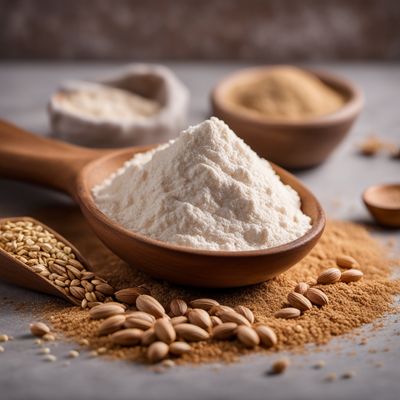
Ingredient
Rye flour, wholemeal
The Wholesome Grain: Rye Flour
Rye flour, wholemeal, is a type of flour made from grinding whole rye grains. It has a darker color and a stronger flavor compared to regular wheat flour. With its nutty and slightly tangy taste, it adds depth to breads, muffins, and pancakes. The texture of rye flour is denser and coarser, resulting in a hearty and rustic crumb. Its appearance is characterized by a light brown color with specks of bran and germ.
Origins and history
Rye flour has been a staple in European cuisine for centuries, particularly in countries like Germany, Scandinavia, and Russia. It has played a significant role in traditional bread-making techniques and cultural dishes. Rye flour's hardy nature made it a popular choice in regions with colder climates, where it could be grown more successfully than wheat. Its historical significance is deeply rooted in the culinary traditions of these regions.
Nutritional information
Rye flour, wholemeal, is a good source of dietary fiber, providing approximately 8 grams per 100 grams. It also contains essential minerals such as manganese, phosphorus, and magnesium. Additionally, it offers a moderate amount of protein and is lower in gluten compared to wheat flour.
Allergens
Rye flour may contain gluten, making it unsuitable for individuals with gluten sensitivities or celiac disease.
How to select
When selecting rye flour, look for packages that are tightly sealed and free from moisture or signs of insect infestation. Opt for brands that use organic or non-GMO rye grains for a higher quality product. Check the expiration date to ensure freshness.
Storage recommendations
To maintain the freshness of rye flour, store it in an airtight container in a cool, dry place, away from direct sunlight. Refrigeration or freezing can extend its shelf life, especially in warmer climates. However, bring it to room temperature before using to prevent condensation.
How to produce
Rye flour can be produced by grinding whole rye grains into a fine powder using a grain mill or a high-powered blender. It can also be purchased pre-ground from specialty stores or online retailers.
Preparation tips
Rye flour can be used in a variety of recipes, including breads, muffins, pancakes, and cookies. It is commonly used in traditional European breads like rye sourdough and pumpernickel. When baking with rye flour, it is often combined with wheat flour to improve the texture and rise of the final product. Rye flour can also be used as a thickening agent in soups and stews.
Substitutions
Whole wheat flour, spelt flour, or a combination of all-purpose flour and wheat bran can be used as substitutes for rye flour in recipes. However, keep in mind that the flavor and texture may differ slightly.
Culinary uses
Rye flour is commonly used in traditional European breads, such as German rye bread, Swedish limpa bread, and Russian black bread. It is also used in Scandinavian pastries like rugbrød and Danish rye buns. Additionally, rye flour can be incorporated into pancakes, waffles, and muffins for a heartier and more flavorful twist.
Availability
Rye flour is commonly available in Europe, particularly in countries like Germany, Sweden, and Russia. It can also be found in specialty stores or online retailers worldwide.


